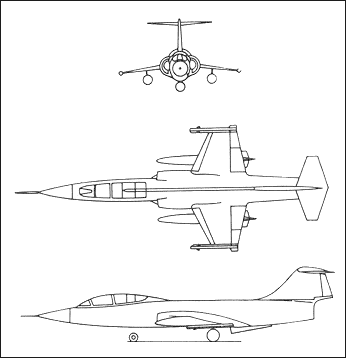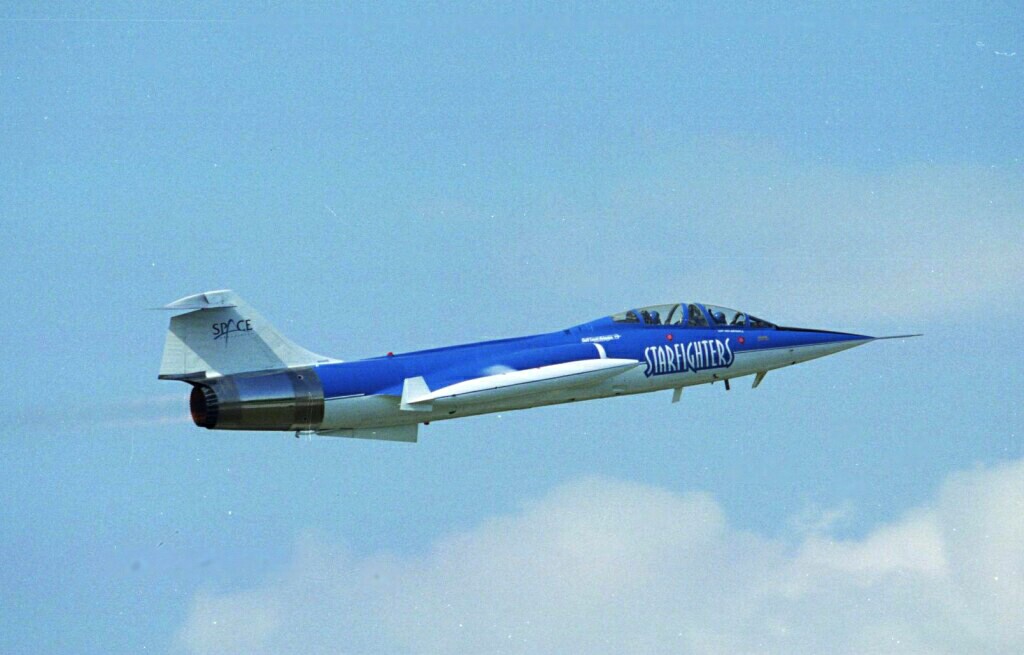|

DESCRIPTION:
Experience in the Korean War showed that the US Air Force was in need of a new interceptor capable of high speeds and climb rates to engage Russian MiG-15s and bombers. The solution adopted by Lockheed was a small, lightweight design with a powerful engine called the F-104. Though capable of speeds exceeding Mach 2 and of reaching altitudes exceeding 90,000 ft, the Starfighter suffered from limited range, poor turn radius, limited payload-carrying space, and unforgiving flight characteristics. The F-104 was used for a time by both the Strategic Air Command as a bomber interceptor and the Tactical Air Command as a fighter bomber, but production was stopped in 1959 and the aircraft withdrawn from front-line service in 1960. However, West Germany accepted the new F-104G with improved avionics and better low-level strike capabilities as its primary fighter. The 'G' model soon found customers throughout Europe, Asia, and in Canada. Though only 296 examples were built for the USAF, an additional 2,282 were built for US allies. These exceptional aircraft served for many years but were finally withdrawn from service by the mid-1990s. The lone variant still surviving is the F-104S built under license by Alenia in Italy for use in Italy and Turkey. Despite the age of the F-104, the 'S' model has proven to be cost-effective, reliable, and popular among pilots giving the F-104 a new lease on life until at least the turn of the century.
|
|

| PROPULSION: |
| Powerplant |
one General Electric J79-19 turbojet |
Thrust
|
10,000 lb (44.5 kN)
15,800 lb (70.28 kN) with afterburner
|
| PERFORMANCE: |
| Max Level Speed |
at altitude: 1,450 mph (2,335 km/h) at 36,000 ft (10,975 m), Mach 2.2
at sea level: Mach 1.2 |
| Initial Climb Rate |
50,000 ft (15,239 m) / min |
| Service Ceiling |
58,000 ft (17,680 m)
90,000 ft (27,430 m) zoom ceiling |
| Range |
typical: 260 nm (480 km) with max payload
ferry: 1,576 nm (2,920 km) |
g-Limits
|
unknown
|
| ARMAMENT: |
| Gun |
one 20 mm M61A1 Vulcan cannon (750 rds) |
| Stations |
7 external hardpoints and 2 wingtip rails |
| Air-to-Air Missile |
AIM-9 Sidewinder, AIM-7 Sparrow, Apside |
| Air-to-Surface Missile |
AGM-65 Maveric, Kormoran, Penguin |
| Bomb |
nuclear bombs, Mk 82/83 GP, cluster bombs |
Other
|
rocket pods, ECM pods
|
| KNOWN VARIANTS: |
| XF-104 |
Prototype |
| YF-104 |
Pre-production aircraft used to test different engines; 17 built |
| F-104A |
Production model for USAF with blown flaps to reduce landing speeds; 153 built |
| NF-104A |
F-104As used for astronaut training; 3 redesignated |
| QF-104A |
YF-104/F-104A aircraft used as radio-controlled target drones |
| F-104B |
Two-seat trainer based on F-104A but with new fuel system and armament layout; 26 built |
| F-104C |
Upgraded one-seat tactical fighter bomber used by USAF, new engine, armed with Sidewinder missiles or bombs and rocket pods; 77 built |
| F-104D |
Two-seat trainer based on 'C' model; 21 built |
| CF-104D |
Canadian two-seat trainer built under license; 38 built |
| F-104DJ |
Two-seat trainer for Japan; 20 built |
| F-104F |
Improved attack fighter based on 'D' model used by Germany; 30 built |
| F-104G |
German multi-role fighter with ground attack capability, aerodynamic refinements, stronger airframe, more advanced avionics, and new engine; 1,127 built for European countries |
| TF-104G |
German two-seat trainer; 220 built |
| RF-104G |
German reconnaissance model with a camera pod in place of the Vulcan cannon; 189 built |
| RTF-104G |
Two-seat trainer that can be equipped for reconnaissance duties |
| CF-104 |
Canadian multi-role fighter based on F-104G built under license; 200 built |
| F-104J |
Japanese multi-role fighter based on F-104G built under license; 210 built |
| F-104N |
F-104G aircraft built for NASA as supersonic chase planes |
| F-104S |
Multi-role fighter based on F-104G built by Aeritalia for Italy and Turkey, last operational version; 245 built |
| F-104S-ASA |
Italian F-104S models upgraded by Aeritalia/Alenia with new radar, avionics, and weapon systems; 150 converted |
|
|  |
|

| HISTORY: |
| First Flight |
(XF-104) 7 February 1954 |
| Service Entry |
January 1958
|
| CREW: |
1 pilot
|
| ESTIMATED COST: |
unknown
|
| AIRFOIL SECTIONS: |
| Wing Root |
Biconvex 3.36% |
| Wing Tip |
Biconvex 3.36%
|
| DIMENSIONS: |
| Length |
54.75 ft (16.69 m) |
| Wingspan |
21.92 ft (6.68 m) |
| Height |
13.50 ft (4.11 m) |
| Wing Area |
196.1 ft2 (18.22 m2) |
Canard Area
|
not applicable
|
| WEIGHTS: |
| Empty |
14,082 lb (6,387 kg) |
| Typical Load |
unknown |
| Max Takeoff |
28,779 lb (13,054 kg) |
| Fuel Capacity |
internal: 5,822 lb (2,641 kg)
external: 5,538 lb (2,512 kg) |
Max Payload
|
4,310 lb (1,995 kg)
|
|
|

| KNOWN COMBAT RECORD: |
Vietnam War (USAF, 1965-1968)
Bangladesh War (Pakistan, 1971)
|
| KNOWN OPERATORS: |
US Air Force
Belgium
Canada
Denmark
German Air Force
German Navy
Greece
Italy
Japan
Netherlands
Norway
Pakistan
Spain
Taiwan
Turkey
|
| 3-VIEW SCHEMATIC:
|
SOURCES:
- Bishop, Chris, ed. The Encyclopedia of Modern Military Weapons: The Comprehensive Guide to Over 1,000 Weapon Systems from 1945 to the Present Day. NY: Barnes & Noble, 1999, p. 261, 297.
- Donald, David, ed. The Complete Encyclopedia of World Aircraft. NY: Barnes & Noble, 1997, p. 578.
- Gunston, Bill and Spick, Mike. Modern Air Combat: The Aircraft, Tactics and Weapons Employed in Aerial Combat Today. NY: Crescent Books, 1983, p. 116-117.
- Isby, David C. Jane's Fighter Combat in the Jet Age. London: Harper Collins Publishers, 1997, p. 185.
- Munro, Bob and Chant, Christopher. Jane's Combat Aircraft. Glasgow: Harper Collins Publishers, 1995, p. 136-137.
- Paul Nann's Military Aviation Photo Gallery
- Spohrer, Jennifer. Jane's Combat Simulations: USNF '97 Users Manual. San Mateo, CA: Electronic Arts, 1996, p. 8.29-8.31.
|
|
|




